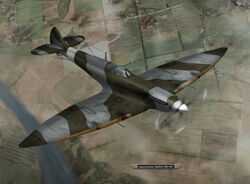| Spitfire MK-VII | |
|---|---|
 | |
| Information | |
| Power | Allied |
| Country | Britain |
| Type | Fighter |
| Level | 30 |
| Precursor | Supermarine Spitfire Mark V |
| Successor | Supermarine Spitfire Mark IX |
| Peers | |
| Vital statistics | |
| Speed | 7 |
| Agility | 8 |
| Attack | 5 |
| Defense | 5 |
| Eng Temp | 4 |
| Accelerate | 6 |
| Decelerate | 6 |
| Machine Guns | 4 |
| Cannons | 2 |
| Weapons | 4 |
| Bombs | 2 |
| Features | |
| Low Altitude | - |
| Medium Altitude | Agility +5% |
| High Altitude | - |
The Supermarine Spitfire
The Supermarine Spitfire is a British single-seat fighter aircraft that was used by the Royal Air Force and many other Allied countries during and after the Second World War. The Spitfire was built in many variants, using several wing configurations, and was produced in greater numbers than any other British aircraft. It was also the only British fighter to be in continuous production throughout the war. The Spitfire continues to be a popular aircraft, with approximately 53 Spitfires being airworthy, while many more are static exhibits in aviation museums all over the world.
The Spitfire was designed as a short-range, high-performance interceptor aircraft.
During the Battle of Britain (July–October 1940), the Spitfire was perceived by the public to be the RAF fighter, though the more numerous Hawker Hurricane shouldered a greater proportion of the burden against the Luftwaffe. However, because of its higher performance, Spitfire units had a lower attrition rate and a higher victory-to-loss ratio than those flying Hurricanes.
The Mark VII
One intriguing feature of the Spitfire story is that the two most important versions introduced during the war, the Mk V and the Mk IX, were both seen as interim designs, produced to fill a gap while more heavily modified and theoretically more advanced versions entered production. The Mk VII (pressurised) and Mk VIII (unpressurised) Spitfires were intended to replace the Mk V.
The Mk VII used the closely related Merlin 61 (1,300hp at 23,000ft), 64 (1,450hp at 21,000ft) and 71 (1,700hp at 18,000) engines as they appeared. The Merlin 61 was the first two-speed two-stage supercharged engine used in the Spitfire – the two stage supercharger improved performance at high altitude. The new engines required a new cooling system, one result of which was that the Mk VII had an air scoop on each wing, giving it a more symmetrical appearance than earlier Spitfires. The length of the fuselage was increased to 31ft 3.5in in early model to accommodate the larger engine. The fuselage also had to be strengthened.
The Mk VII used the “c” type universal wings, capable of carrying either eight machine guns, four cannon or two cannon and four machine guns depending on the situation, but with the extended wing tips used on the Mk VI.
The Mk VII was a pressurised fighter. It had a more advanced pressurisation system than the Mk VI, using a sliding cockpit canopy, which was more popular than the locked cockpit on the Mk VI. The best high altitude version of the Mk VII was powered by the Merlin 71, and could reach 416mph at 44,000 ft.
The Mk VII remained in production from August 1942 until early in 1944, although only 140 aircraft were produced in that time. The Mk VII was a little more successful than the earlier Mk VI, but the “interim” Mk IX turned out to be capable of operating high altitude itself, and the Mk VII soon lost its special status as a high altitude fighter, although it remained in use throughout the war.